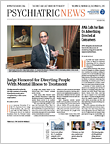Psychiatrists’ fundamental ethical responsibilities do not change when they take up a new form of practice, but the introduction of a new technology—such as telepsychiatry to treat patients at a remote distance—raises new ethical challenges that call for the kind of observation and deliberative thinking that has informed ethical practice in traditional settings.
So say James Sabin, M.D., director of the ethics program at Harvard Pilgrim Health Care, and Kathryn Skimming, M.D., a PGY-1 trainee in psychiatry at the University of Maryland-Sheppard Pratt residency program, in an article appearing in a special edition of the International Review of Psychiatry on telepsychiatry. The article is titled “A Framework for Ethics of Telepsychiatry Practice.”
Sabin and Skimming stated that a core ethics principle that should be maintained in telepsychiatry is the integrity of the physician-patient relationship.
“The technology associated with telepsychiatry is new and has the buzz of something exciting and disruptive and transformative, but it is crucial that the core values that have been developed over decades in familiar traditional settings should be maintained in telepsychiatry or any new mode of treatment,” Sabin told Psychiatric News. “The medium is different, but the values to guide what happens when using that medium are the same.”
Sabin is also professor in the departments of population medicine and psychiatry at Harvard Medical School and a member of the AMA Council on Judicial and Ethical Affairs. Skimming is a past student member of the council.
Skimming said that since a base of experience and ethical wisdom about the practice of telepsychiatry does not exist, she and Sabin focused on the physician-patient relationship as “vital and important.”
They addressed six areas in which telepsychiatry may pose ethical challenges; one is “providing competent, safe care.” They noted that an aspect of competent, safe care is affective communication and empathic connection, and they raised the question of whether the medium of telepsychiatry might impede or compromise such connection. A review of the existing literature suggests it does not.
“In fact, multiple studies suggest that psychiatrists and patients do not find that virtual meetings impede empathic connection,” they wrote. “Nevertheless, clinicians practicing telepsychiatry should be alert to [those concerns]. A case report in which the webcam did not pick up a quietly voiced suicidal statement illustrates the need for a ‘competent’ web connection. And psychiatrists collectively have an ethical responsibility to study the conditions under which telepsychiatry is more and less effective, in the same manner that competent use of new medications and psychotherapies requires guidance from clinical research.”
Sabin said he believes the preservation of the empathic connection in telepsychiatry speaks to the capacity of individuals to infuse richness and meaning into meetings between two people even when they do not “meet” in person. “When the technology is done right, the studies of telepsychiatry are impressive in terms of patient satisfaction,” Sabin said.
Skimming added, “This new mode of communication reshapes the clinical encounter, but it appears that people can still believe in the doctor-patient relationship. The studies we looked at really show that sometimes people would prefer a telepsychiatric experience. If you can use the technology appropriately, you don’t miss out on those interpersonal cues that one normally expects in a traditional setting.”
The other five areas they addressed in their article are ensuring informed consent, promoting privacy and confidentiality, managing boundaries, encouraging continuity of care, and addressing health equity.
In comments to Psychiatric News, Sabin and Skimming emphasized that informed consent for telepsychiatry has to be more exacting than the kinds of “consent” individuals have become accustomed to providing when consenting to online terms of agreement using a laptop or smartphone.
“Patients need to understand how the telepsychiatric consult might be different,” Skimming said. “Because the therapist isn’t physically present, there may be some challenges, and the clinician may not be able to respond in the same manner as he or she might if present in the same room. People need to understand that and plan for anticipated challenges.”
They cite a seminal article on telepsychiatry by Jay Shore, M.D., M.P.H., an associate professor at the University of Colorado, appearing in the March 2013 American Journal of Psychiatry. Shore wrote that informed consent “should involve the psychiatrist introducing him or herself and identifying his or her location, organization, and certification. All parties present at both the patient’s and the psychiatrist’s sites should be introduced, and the psychiatrist should pan the camera around the room he or she is using so the patient can see who is present and be familiar with the psychiatrist’s room setup. … A review of the benefits and risks of telepsychiatry and alternatives (if any) should be conducted. At the end of this orientation, the psychiatrist should ask if the patient has any questions about these issues before beginning a clinical interview. … The psychiatrist should monitor the patient’s level of comfort during the session and at the conclusion ask how the patient felt about using videoconferencing.”
The management of boundaries may not be so clear-cut in a telepsychiatric situation as in a more typical clinical encounter. “Emerging examples of physician violations of professionalism on social media raise a concern that for some clinicians the online environment may lead to ethical lapses that might not occur in an in-person setting,” Sabin and Skimming wrote. “This risk could be accentuated for clinicians practicing telepsychiatry from a home setting interacting with patients who are also at home, possibly at a time that would be unusual for an in-person appointment, such as a late evening or weekend. It is possible to imagine that this configuration could be experienced by either or both parties as something akin to online socializing rather than psychiatric care, thereby conducing to boundary violations.”
Sabin said that with regard to managing boundaries in a telepsychiatric setting—as with other potential ethical challenges—what will be necessary is clinical experience, thoughtful ethical reflection and deliberation, and the development over time of a store of ethical wisdom in the literature. “Our ethics guidelines for psychiatric practice in familiar settings have been derived from years of experience,” Sabin said. “We need the same for telepsychiatry. It will be useful to have thoughtful observation and the development of a literature that can provide us a more fully informed and richly textured ethical guidance.” ■
“A Framework of Ethics for Telepsychiatry Practice” can be accessed
here.


